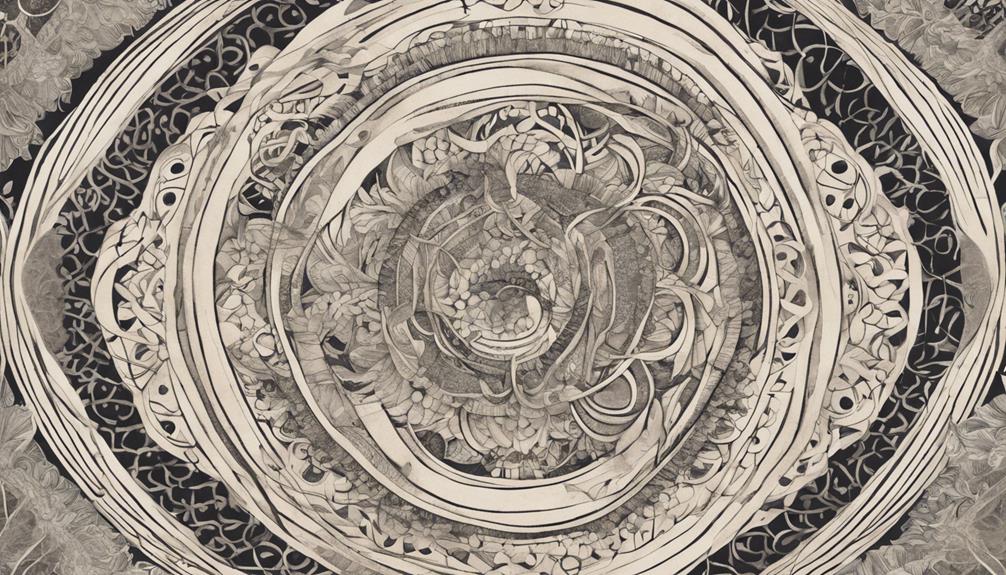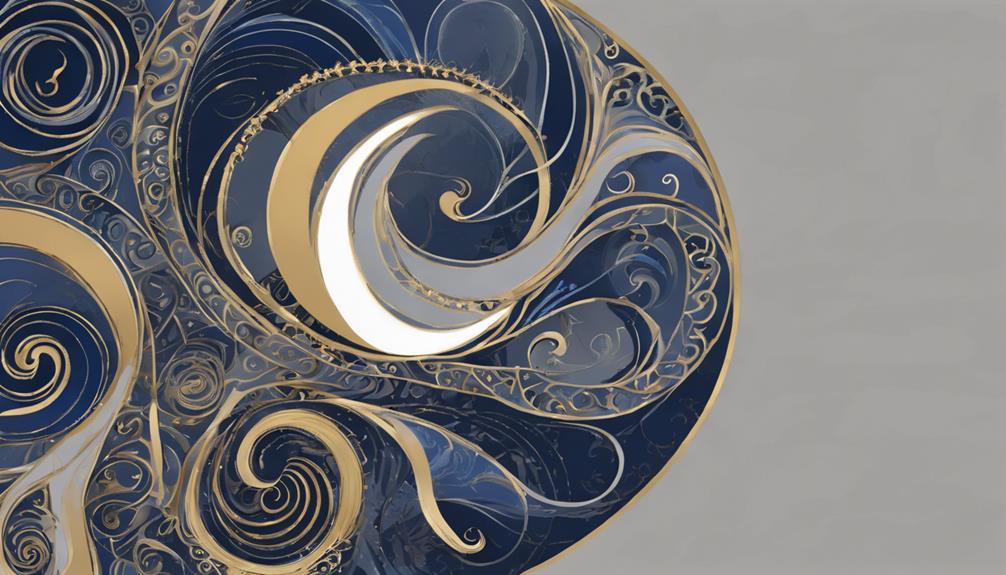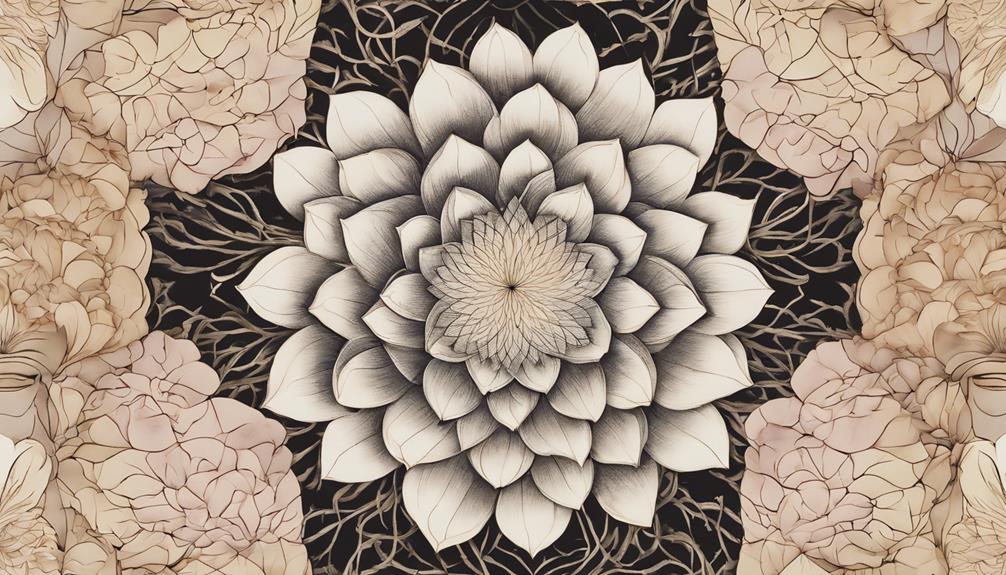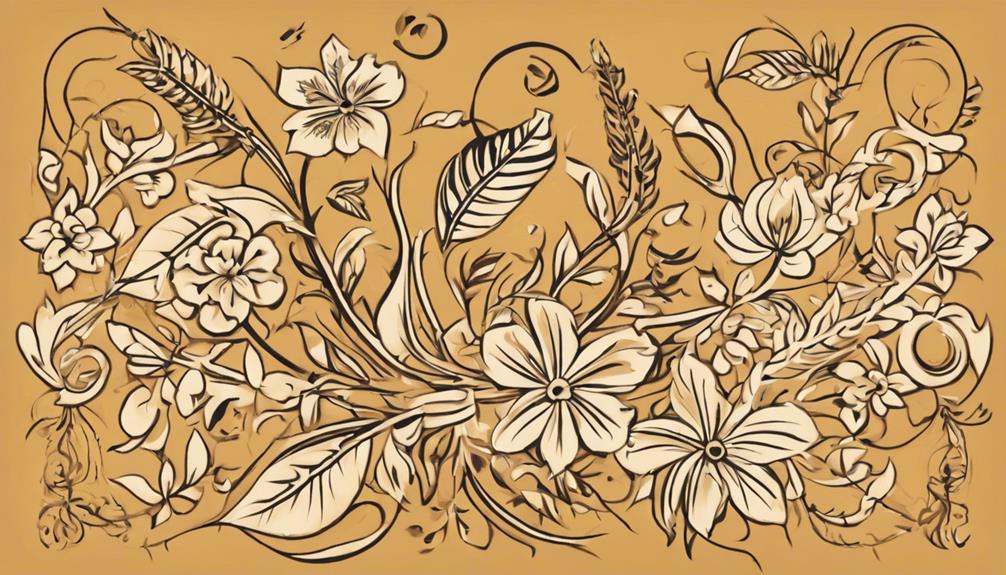As you venture into the domain of Pantoum poetry, you'll discover the art of mastering repetition and variation. This traditional Malay form demands meticulous attention to crafting a sense of continuity and cohesion, while introducing subtle variations to convey complex emotions and ideas. By balancing unity and diversity, you'll create a rich tapestry of meaning, where poetic echoes resonate with cultural significance. As you navigate the intricate structure, you'll uncover the nuances of this ancient form, and discover how to distill themes and emotions with precision. And as you progress, the subtle harmonies of Pantoum will reveal their secrets to you.
Understanding the Pantoum Structure

As you explore the world of pantoum poetry, you'll discover that its structure is rooted in a unique repetition pattern, where specific lines are repeated throughout the poem in a specific order, creating a sense of musicality and introspection. This intricate pattern is a hallmark of pantoum origins, which can be traced back to Malay folk poetry. The pantoum's cultural significance lies in its ability to convey complex emotions and ideas through a nuanced and layered approach.
The repetition pattern, which involves repeating lines in a specific order, creates a sense of rhythm and musicality, drawing the reader into the poet's introspective world. This unique structure allows the poet to explore themes and emotions in a way that is both subtle and powerful. As you investigate further into the world of pantoum poetry, you'll come to appreciate the complexity and beauty of this traditional Malay form, which has captivated readers and poets alike with its haunting melodies and profound insights.
Repetition and Variation Techniques

In mastering the art of pantoum poetry, you'll find that the strategic use of repetition and variation techniques can elevate your craft, allowing you to convey complex emotions and ideas with precision and subtlety. By skillfully manipulating the repetition of lines, you can create a sense of continuity and cohesion, while also introducing subtle variations that add depth and nuance to your poem. This interplay between repetition and variation allows you to modulate the vocal cadence of your poem, creating a dynamic rhythm that engages the reader. Moreover, the careful use of poetic echoes – where repeated lines are varied and recontextualized – can create a rich tapestry of meaning, as the reader is encouraged to tease out the subtle differences and connections between repeated lines. By mastering these techniques, you can create a pantoum that is at once both structurally cohesive and richly nuanced, conveying complex emotions and ideas with precision and subtlety.
Rhyme and Musicality in Pantoum

Your pantoum's musicality is deeply intertwined with its rhyme scheme, which can either harmonize or clash with the repetition of lines, and it's crucial to carefully consider the sonic implications of your rhyme choices to create a cohesive and engaging poem. As you craft your pantoum, remember that the rhyme scheme is not just a decorative element, but a critical component that can elevate or undermine the overall musicality of your poem. A well-chosen rhyme scheme can create a sonorous cadence, weaving together the repeated lines to form a rich tapestry of sound. Conversely, a poorly chosen rhyme scheme can disrupt the rhythmic echoes, creating a jarring effect that disrupts the reader's experience. To strike the right balance, consider the natural rhythms of the Malay language and the cultural context of the pantoum form. By doing so, you'll be able to craft a pantoum that not only showcases your mastery of the form but also resonates with readers on a deeper level.
Embracing Traditional Malay Folk Roots

One of the most effective ways to explore your pantoum with authenticity is to immerse yourself in the rich cultural heritage of traditional Malay folk roots, which have influenced the form's unique character and aesthetic over time. By delving into the cultural heritage of Malay folk traditions, you'll uncover a treasure trove of folkloric inspiration that can enrich your poetry. The Malay folk roots are characterized by a deep sense of community, storytelling, and oral traditions, which can inform your pantoum's structure, imagery, and themes. You'll discover a wealth of inspiration in the myths, legends, and folktales that have been passed down through generations of Malay storytellers. By embracing these traditional roots, you'll be able to craft a pantoum that resonates with the cultural essence of the form. As you explore the cultural heritage of Malay folk roots, you'll find that your poetry becomes more nuanced, layered, and authentic.
Conveying Emotions Through Repetition

Through the deliberate repetition of lines and stanzas, you can masterfully evoke a sense of longing or nostalgia in your pantoum, much like the haunting refrain of a traditional Malay folk song. This strategic use of repetition enables you to tap into the emotional resonance of your poem, creating a profound impact on your readers. By echoing certain lines or phrases, you can amplify the emotional intensity of your poem, conjuring up sentimental echoes that linger long after the poem has ended. The key lies in striking a balance between repetition and variation, allowing the repeated elements to resonate deeply while the varied elements keep the poem fresh and engaging. As you navigate this delicate balance, remember that the emotional resonance of your pantoum depends on the careful calibration of these two forces. By mastering this interplay, you can craft a poem that not only conveys emotions but also leaves a lasting impression on your readers.
Creating Continuity Through Refrain

In crafting a pantoum, you'll find that refrains, strategically placed throughout the poem, can forge a sense of continuity, subtly guiding the reader's emotional journey. By repeating specific lines or phrases, you create a sense of cultural resonance, evoking a shared understanding between the poet and the reader. This repetition also generates musical echoes, imbuing the poem with a rhythmic quality that enhances its emotional impact.
As you weave refrains throughout your pantoum, you're able to establish a sense of cohesion, drawing the reader's attention to the poem's central themes and motifs. This, in turn, allows you to explore complex ideas and emotions with greater nuance, creating a rich tapestry of meaning that rewards close reading. By carefully calibrating the placement and frequency of your refrains, you can modulate the poem's tone and atmosphere, creating a sense of dynamic tension that propels the reader forward.
Balancing Unity and Variation

As you endeavor to craft a pantoum that resonates with readers, you'll need to strike a delicate balance between unity and variation, carefully calibrating the repetition of refrains to create a sense of cohesion while avoiding monotony. This balance is essential, as it allows your pantoum to achieve cultural resonance, speaking to the hearts of your audience. Achieving poetic cohesion requires a deep understanding of the interplay between repetition and variation. By thoughtfully selecting which lines to repeat and how to vary them, you can create a sense of continuity that ties the entire poem together. However, if you're not careful, repetition can quickly become monotonous, leading to a sense of stagnation. To avoid this, carefully consider the placement and variation of refrains, using them to create a sense of tension and release. By walking this tightrope between unity and variation, you can craft a pantoum that is both cohesive and dynamic, resonating with readers on a deep level.
Exploring Themes in Pantoum Poetry

By carefully exploring the balance between unity and variation, you've set the stage for investigating the rich thematic terrain that pantoum poetry has to offer, where the intentional repetition of refrains can amplify the resonance of your core ideas and emotions. As you immerse yourself in the world of pantoum poetry, you'll discover that the form lends itself particularly well to exploring themes that possess cultural significance. The repetition of refrains can serve as a powerful tool for conveying the collective experiences and emotions that define a culture. Additionally, the pantoum's unique structure allows for the expression of universal themes that transcend cultural boundaries, speaking to fundamental human experiences that resonate with readers from diverse backgrounds. By skillfully utilizing the pantoum form, you can craft poems that not only capture the essence of a particular culture but also tap into the universal human experience, making your poetry relatable and impactful to a broad audience.
Crafting Meaning Through Repetition

Through deliberate repetition, you're able to distill the essence of your theme, allowing the refrain to reverberate with increased intensity, thereby imbuing your pantoum with a profound sense of significance. This strategic reuse of language enables you to tap into the cultural resonance of your chosen theme, evoking a shared understanding and emotional connection with your audience. As you interweave repeated lines, you create poetic echoes that resonate throughout the poem, amplifying the emotional impact and reinforcing the central idea. By doing so, you craft a rich tapestry of meaning that unfolds with each successive iteration, inviting the reader to uncover new layers of interpretation. Through this masterful use of repetition, you're able to convey the complexity and depth of your theme, rendering your pantoum a nuanced and thought-provoking exploration of the human experience.
Mastering the Art of Pantoum Composition

You'll find that mastering the art of pantoum composition requires a meticulous attention to the intricate dance of repetition and variation, as you carefully calibrate the poem's rhythmic pulse to resonate with your audience. This harmonious balance is key to crafting a pantoum that not only showcases your technical skill but also conveys the cultural significance of this traditional Malay form. As you navigate the pantoum's unique structure, you'll discover that it's not just a matter of repeating lines, but rather, it's an art that demands a deep understanding of the evolution of this poetic form. By studying the historical development of the pantoum, you'll gain insight into the cultural context that has shaped this art form over time. This knowledge will enable you to infuse your composition with a depth of meaning that resonates with readers. Remember, the pantoum is not just a technical exercise, but a powerful medium for storytelling and cultural expression.
Frequently Asked Questions
Can Pantoum Poetry Be Written in Languages Other Than Malay?
As you ponder the possibilities, recall the words of T.S. Eliot, "We shall not cease from exploration, and the end of all our exploring will be to arrive where we started and know the place for the first time." Indeed, the pantoum form can be explored globally, transcending linguistic boundaries. You might wonder, can pantoum poetry be written in languages other than Malay? The answer lies in its linguistic flexibility, allowing the form to adapt and thrive in diverse cultural contexts.
Is the Pantoum Form Only Used for Traditional Folk Themes?
As you explore the world of pantoum poetry, you'll find that it's not limited to traditional folk themes. While it's true that pantoum originated in Malay culture, its adaptability and cultural significance transcend historical context. You'll discover that this poetic form can be applied to various themes, exploring nuances of human experience, and it's this versatility that has contributed to its enduring appeal.
How Do I Choose the Right Refrain for My Pantoum Poem?
Choosing the right refrain for your pantoum poem is like finding the perfect key to open a treasure chest – it must resonate deeply. You want a refrain that echoes through your poem like a lyrical whisper, weaving a subtle thread of connection between stanzas. Look for a phrase that distills the essence of your poem, then repeat and vary it to create a sense of harmony and tension, allowing the refrain's resonance to amplify your poem's emotional impact.
Can I Use Enjambment in a Pantoum Poem for Musicality?
When experimenting with enjambment in your pantoum poem, you'll want to carefully consider the line level emphasis. By allowing a sentence or phrase to continue into the next line without punctuation, you can create a sense of flow and musicality. Pay attention to syllable stress, as enjambment can alter the natural emphasis of words, and make adjustments accordingly. This technique can add complexity and interest to your poem, but use it judiciously to avoid disrupting the overall rhythm.
Are There Any Famous Pantoum Poets I Should Read for Inspiration?
You're likely familiar with the Pantoum pioneers like Victor Hugo and Théodore de Banville, who experimented with the form in the 19th century. For modern masters, consider reading the works of Donald Justice, who skillfully employed the Pantoum to explore themes of love and mortality. Additionally, poets like Marilyn Hacker and Jacqueline Osherow have pushed the boundaries of the form, offering innovative takes on the traditional Pantoum.


